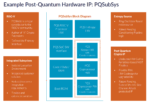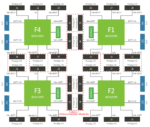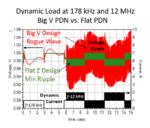The chase to add artificial intelligence (AI) into many complex applications is surfacing a new trend. There’s a sense these applications need a lot of AI inference operations, but very few architects can say precisely what those operations will do. Self-driving may be the best example, where improved AI model research and discovery… Read More
Author: Don Dingee
A clear VectorPath when AI inference models are uncertain
Post-quantum cryptography steps on the field
In cybersecurity circles, the elephant in the room is a quantum computer in the hands of nefarious actors. A day is coming, soon, when well-funded organizations will be able to rent time on, or maybe even build or buy a quantum machine. Then, if data is valuable enough, people will hunt for it. Two or three months of compute time on a … Read More
EasyVision: A turnkey vision solution with AI built-in
Artificial intelligence (AI) is reserved for companies with hordes of data scientists, right? There’s plenty of big problems where heavy-duty AI fits. There’s also a space of smaller, well-explored problems where lighter AI can deliver rapid results. Flex Logix is taking that idea a step further, packaging their InferX X1 edge… Read More
Seeing 1/f noise more accurately
Electronics noise is often described as “white,” spread evenly across a band, typical on older semiconductor processes where thermal and shot noise dominate. As transistors shrink, “pink” 1/f noise takes over at low frequencies – becoming stronger in advanced processes and quantum computing technology. But it’s not an easy… Read More
RISC-V embedded software gets teams coding faster
RISC-V processor IP is abundant. Open-source code for RISC-V is also widely available, but typically project-based code solves one specific problem. Using only pieces of code, it’s often up to a development team integrate a complete application-ready stack for creating an embedded device. A commercial embedded software development… Read More
Flexible prototyping for validation and firmware workflows
The quest for bigger FPGA-based prototyping platforms continues, in lockstep with each new generation of faster, higher capacity FPGAs. The arrival of the Xilinx Virtex UltraScale+ VU19P FPGA takes capacity to new levels and adds transceiver and I/O bandwidth. When these slot into S2C’s Prodigy S7-19P Logic System, the result… Read More
[WEBINAR] Secure your devices with PUF plus hardware root-of-trust
It’s a hostile world we live in, and cybersecurity of connected devices is a big concern. Attacks are rising rapidly, and vulnerabilities get exploited immediately. Supply chains are complex. Regulations are proliferating. Secrets don’t stay secrets for long – in fact, the only secret in a system with open-source algorithms… Read More
Unlocking PA design with predictive DPD
Next up in this series on modulated signals is an example of multi-dimensional EM design challenges: RF power amplifiers (PAs). Digital pre-distortion (DPD) is a favorite technique for linearizing PA performance. Static effects are easy to model and correct, but PAs are notorious for interrelated dynamic effects spoiling … Read More
Shift left gets a modulated signal makeover
Everyone saw Shift Left, the EDA blockbuster. Digital logic design, with perfect 1s and 0s simulated through perfect switches, shifted into a higher gear. But the dark arts – RF systems, power supplies, and high-speed digital – didn’t shift smoothly. What do these practitioners need in EDA to see more benefits from shift left? … Read More
WEBINARS: Board-Level EM Simulation Reduces Late Respin Drama
Advanced board designs are fertile ground for misbehavior in time and frequency domains. Relying on intuition, then waiting until near-final product for power integrity (PI) or EMI testing almost guarantees board respins are coming. Lumped-parameter simulations of on-board power delivery networks (PDNs) struggle with … Read More



















The Quantum Threat: Why Industrial Control Systems Must Be Ready and How PQShield Is Leading the Defense